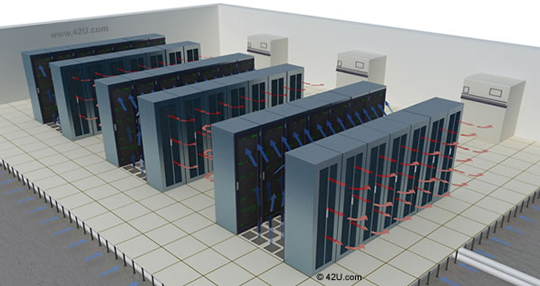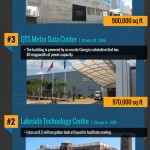Most people find that at some point they have to escape the sizzling summer heat. It can be hard enough to keep your living space at a comfortable temperature when things get hot outside. Imagine how difficult it must be to maintain a cool climate in a room with many servers humming away, producing even more heat on a daily basis.
Temperature is a big issue when maintaining a data center, especially in San Diego and Phoenix where late summer can reach temperatures into the 90s (San Diego) and 110s (Phoenix). So how do businesses manage to keep their machines running cool and safe?
Keep the Server Layout Sparse
If you try to squeeze many servers into one small area, they are going to quickly raise the surrounding temperature. Air flow will be restricted and each server will help heat the others. The best way to avoid this is to create a layout that is sparser and gives each server a little space to breathe. You may not be able to fit as many servers in a specific area, but it will be better in the long run to avoid the risk of overheating.
Organize Your Server Cables
Cables may seem unrelated to server room heating, but they actually can have a big impact on temperature. More servers means more cables must be managed. Cables that aren’t organized can capture the heat that pours from the back of each server. Excess heat may end up being siphoned back into the machine. Streamline your cables so hot air can flow right through the center.
Image Source: justcabling.com
Spot Cooling is Helpful for Small Data Centers
If you maintain a smaller data center or server room, then spot cooling may be a great way to go. This allows you to tackle high temperature areas without installing a big, elaborate system. Setup portable cooling devices wherever they are needed the most. This method is not recommended for larger server centers.
Install Blanking Panels to Keep Air Flowing
Blanking panels can be installed on unused server racks to keep the air flow where it needs to be. This process is relatively simple and can give you greater control over temperature throughout the server room. This method should be used along with other cooling solutions.
Image Source: Videk.co.uk
Create Hot and Cold Only Aisles between Servers
Instead of placing each server in the same position, create alternating rows. This can be done by making each row face one another. An alternating arrangement produces entire aisles that create cold or hot air only. The idea is that the back of the server will face the back of the servers in the next row so all the hot air is flowing into one area instead of mixing cold and hot in each aisle. The heat is contained and can be easier to manage when it’s all in one place.
Stay on Top of Cooling System Maintenance
This may sound obvious, but it’s one server cooling tip that’s easy to forget. Make sure you perform regular maintenance on your cooling system. Have an HVAC professional check it at least 2 to 3 times a year. That way you can identify potential problems before they damage your servers. Regular maintenance is the best way to keep your cooling system operating at optimum levels. It will also reduce server downtime and can help you fix smaller issues before they become expensive problems.
Have a Heat Exhaust System in Place
Cooling your data center is much easier if you have a way to remove heat from the room. An exhaust system will do just that. A plenum is usually used to pull hot air out of the room through the ceiling or floor. It is stored in a separate space that doesn’t contain any equipment or critical infrastructure so it can be harmlessly removed.
Combine Multiple Cooling Methods for Best Results
Chances are you will need more than one of these methods to keep your servers running smoothly. Try combining methods so you get the best results. Each data center has its own set of requirements and obstacles, so there is no one-size-fits-all solution. Come up with a plan that is ideal based on the layout and size of your server room and be prepared to adjust or make changes if problems arise.
















